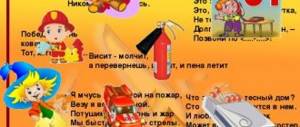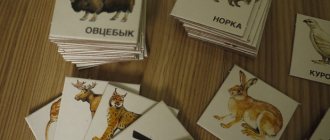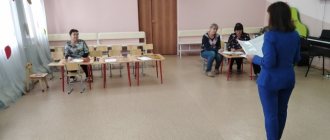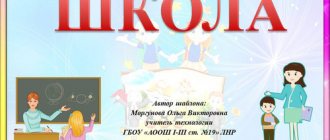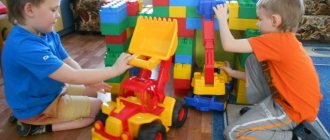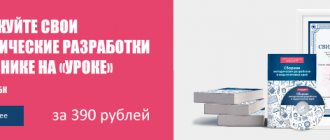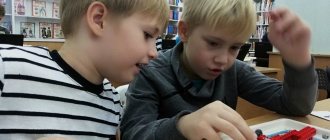Proper preparation for school plays a huge role in the child’s future academic performance, creating for him a smooth transition between classes in kindergarten and everyday school life. In addition, good preparation affects not only academic performance, but also affects the psychological state of the child. Someone who has been well prepared for school takes classes calmly, easily perceives a changed situation, studies steadily, does not get nervous, quickly makes friends, and adapts calmly. In the absence of careful preparation, a sudden change in the situation from kindergarten to school can become a serious stress factor for the child, which will affect not only his studies, but also his health.
Given the role of good preparation for school, parents should be clear about what exactly their children should study in the preparatory group in order to successfully prepare for the first grade of school. At the same time, if we take into account the feedback from hundreds of parents, in many kindergartens the preparatory groups work at a high level, and the children who received training in them do an excellent job in first grade.
General development
In this area, every child should be well prepared for school, where he will have to demonstrate significant independence compared to kindergarten:
- Knowing your own first and last name, birthday, age.
- Knowing the names of parents.
- Home address.
- Knowing the name of your home country.
- Days of the week, months, seasons.
- Knowing the main professions of people and understanding what kind of work they are associated with.
- A child in the preparatory group should know the main domestic and wild animals, as well as the names of their young.
- Understand and explain natural phenomena (the sun shines during the day, it is dark at night, the water is wet, and so on).
- Distinguish between different types of transport.
- Have knowledge of traffic rules.
- Recognize the seasons by external signs (it’s cold in winter, it snows, yellow leaves fall in autumn, and so on).
- Be able to recognize plants by their details (leaves, flowers, berries, etc.).
- The concept of holiday and weekday.
- Understanding the difference between living and nonliving nature.
This basic knowledge can be much broader if the child is developed, but a child prepared for school cannot have more meager knowledge.
From the compiler
This book presents the “Program of Education and Training in Kindergarten” and methodological recommendations for all sections of work with children in the preparatory group for school.
Children in their seventh year of life are on the threshold of school; One of the most important tasks of their upbringing and education in the last year of their stay in kindergarten is comprehensive development, the formation of diverse abilities and preparation for school, taking into account age and mental characteristics.
Along with visual and figurative thinking, preschoolers aged 6–7 years intensively develop verbal and logical thinking, cognitive interests, and independence; the arbitrariness of behavior and actions is strengthened, a higher level of consciousness of one’s capabilities is formed. This requires increasing the complexity of all types of children’s activities and is reflected in the content of work with preschoolers, in preparing them for school, which is carried out in all areas of activity.
The individual characteristics and abilities of children in the school preparatory group are revealed more clearly. Teachers and parents should take this into account, giving children more freedom and independence in expressing preferences in choosing decisions, while at the same time tactfully guiding them, providing assistance as necessary, and positively assessing the results of their actions.
Important conditions for effective work with children in the preschool group according to the “Program of Education and Training in Kindergarten” and “Methodological Recommendations” are:
• continuity between previous age groups and this group, as well as between the preparatory group and primary school;
• the relationship of all sections of educational work with preschoolers, an integrated approach to building the pedagogical process;
• a variety of forms and methods of raising and teaching children, a reasonable combination of classical and innovative areas of work, taking into account the specifics of the content of the work;
• respect for the child and creation of conditions for the development of his various abilities;
• comprehensive preparation of children for school without unnecessary pressure and overload;
• interaction between kindergarten and parents;
• taking into account the specifics of the preschool institution, regional characteristics.
When preparing the manual, the team of authors was based on the achievements of domestic and foreign pedagogical theory and practice.
Motor skills and self-care and hygiene skills
At school, the child will be left more to his own devices, so he should have well-formed and reinforced basic self-care skills:
- Dress and undress independently or with a little help from adults.
- Fasten buttons on clothes, lace up shoes.
- Confident, good at walking, running, jumping and climbing.
- Be able to carry light objects over short distances.
- Throw and catch the ball.
- Play outdoor games.
- Dance.
- Wash your face, wash your hands, brush your teeth, comb your hair yourself.
- Watch your appearance.
- Fold clothes and shoes.
- Show individuality when choosing outfits.
- Ability to properly use a potty and toilet.
- Ability to draw straight lines by hand.
- Ability to draw by cells in a notebook or using rulers.
- Operate with a construction set, create fairly complex structures based on a model or instructions, and also independently come up with new forms.
Fine motor skills play an important role in the development of speech and brain functions, so with children in the preparatory group you need to continue to play a lot, teach them how to do small operations, for example, sewing, knitting, embroidering, stringing beads, of course, within the limits accessible and understandable to preschool children .
Preparatory group for school
⇐ PreviousPage 8 of 10Next ⇒(six to seven years old)
Age-related characteristics of children's mental development
In role-playing games, children of the seventh year of life begin to master complex interactions between people, reflecting characteristic significant life situations, for example, a wedding, the birth of a child, illness, employment, etc.
Game actions become more complex and take on a special meaning that is not always revealed to adults. The playing space is becoming more complex. It can have several centers, each of which supports its own storyline. At the same time, children are able to monitor the behavior of partners throughout the playing space and change their behavior depending on their place in it. Thus, the child already addresses the seller not just as a buyer, but as a buyer-mother or buyer-driver, etc. The performance of a role is emphasized not only by the role itself, but also by the part of the playing space in which this role is played. For example, playing the role of a bus driver, a child commands passengers and obeys the traffic police inspector. If the logic of the game requires the emergence of a new role, then the child can take on a new role during the game, while maintaining the role taken previously. Children can comment on the performance of the role by one or another participant in the game.
Images from surrounding life and literary works conveyed by children in visual activities become more complex. The drawings become more detailed and their color range is enriched. The differences between the drawings of boys and girls become more obvious. Boys willingly depict technology, space, military operations, etc. Girls usually draw female images: princesses, ballerinas, models, etc. Everyday scenes are also common: mother and daughter, room, etc. With the right pedagogical approach Children develop artistic and creative abilities in visual arts.
The image of a person becomes even more detailed and proportional. Fingers, eyes, mouth, nose, eyebrows, chin appear. Clothing can be decorated with various details.
Children in the pre-school group have largely mastered construction using building materials. They are fluent in generalized methods of analyzing both images and buildings; not only analyze the main design features of various parts, but also determine their shape based on the similarity with familiar three-dimensional objects. Free buildings become symmetrical and proportional, their construction is carried out on the basis of visual orientation. Children quickly and correctly select the necessary material. They quite accurately imagine the sequence in which the construction will be carried out, and the material that will be needed to complete it; are able to carry out constructions of varying degrees of complexity, both according to their own plans and conditions.
At this age, children can already master complex addition forms from a sheet of paper and invent their own, but they need to be specially taught this. This type of activity is not only accessible to children, it is important for deepening their spatial understanding.
Design from natural materials becomes more complicated. Children already have access to holistic compositions based on a preliminary plan, which can convey complex relationships and include figures of people and animals in various conditions.
Children continue to develop perceptions, but they cannot always take into account several different signs at the same time. Figurative thinking develops, but the reproduction of metric relationships is difficult. This can be easily checked by asking children to reproduce on a piece of paper a sample on which nine dots are drawn that are not located on the same straight line. As a rule, children do not reproduce metric relationships between points: when drawings are superimposed on each other, the points of the child's drawing do not coincide with the points of the sample.
Generalization and reasoning skills continue to develop, but they are still largely limited to visual signs of the situation.
Imagination continues to develop, but it is often necessary to note a decrease in the development of imagination at this age in comparison with the older group. This can be explained by various influences, including the media, leading to stereotypical images of children.
Attention continues to develop, it becomes voluntary. In some activities, voluntary concentration time reaches 30 minutes.
Children continue to develop speech: its sound side, grammatical structure, vocabulary. Coherent speech develops. Children's statements reflect both the expanding vocabulary and the nature of generalizations that are formed at this age. Children begin to actively use generalizing nouns, synonyms, antonyms, adjectives, etc. As a result of properly organized educational work, children develop dialogic and some types of monologue speech.
In the preschool group, preschool age ends. His main achievements are related to the mastery of the world of things as objects of human culture; children master forms of positive communication with people; Gender identification develops and the student’s position is formed.
By the end of preschool age, the child has a high level of cognitive and personal development, which allows him to successfully study at school in the future.
Objectives of education and training
Continue the comprehensive education and development of children, strengthen their health, and improve physical development. Develop cognitive interests, cultivate sustained attention, observation, develop interest in educational activities and the desire to study at school. Develop the ability to analyze and synthesize, self-control, and self-assessment when performing work.
Based on expanding knowledge about the environment, cultivate patriotic and international feelings, love for the native land, the Motherland. To reinforce the idea that people of different nationalities live peacefully in our country.
Continue to develop labor skills and abilities, cultivate diligence.
Continue to improve all aspects of speech; teach children to use both short and common forms of answer, depending on the nature of the question posed, and to complement the statements of their comrades. Prepare children to learn to read and write. Continue to develop phonemic awareness and speech sound analysis skills.
To develop the artistic and creative abilities of children in various types of artistic activities. Develop aesthetic perception, sense of rhythm, aesthetic appreciation, artistic taste, aesthetic attitude towards the environment, art and artistic activity. Continue to develop an interest in classical and folk art (musical, visual, literature, architecture).
To cultivate organization, discipline, collectivism, respect for elders, a caring attitude towards children, the ability and desire to independently unite for joint play and work, to help each other, and to kindly evaluate the activities of peers.
Continue to develop skills in educational activities: listen carefully to the teacher, act according to the plan he proposes, as well as independently plan your actions, carry out the assigned mental task, and correctly evaluate the results of your activities.
Approximate daily routine
| At home | |
| Getting up, morning toilet | 6.30-7.30 |
| In preschool | |
| Reception, examination, games, duty, morning exercises | 7.00-8.30 |
| Preparation for breakfast, breakfast | 8.30-8.50 |
| Preparation for classes | 8.50-9.00 | |
| Classes | 9.00-11.05 ‘ |
| Preparing for a walk, walk (games, observations, work) | 11.05-12.35 ! |
| Returning from a walk | 12.35-12.45 |
| Preparing for lunch, lunch | 12.45-13.15 |
| Getting ready for bed, naps | 13.15-15.00 |
| Lifting, air, water procedures, games | 15.00-15.25 |
| Preparing for afternoon tea, afternoon tea | 15.25-15.40 |
| Games, work | 15.40-16.30 |
| Preparing for a walk, walk | 16.30-18.00 |
| Returning from a walk | 18.00-18.20 |
| Preparing for dinner, dinner | 18.20-18.45 |
| Games, children going home | 18.45-19.00 |
| \At home | |
| Walk | 19.00-20.15 |
| Returning from a walk, quiet games, hygiene procedures | 20.15-20.45 |
| Night sleep | 20.45-6.30 (7.30) |
Physical education
Continue to improve the health of children and introduce them to a healthy lifestyle. To develop creativity, independence, initiative in motor actions, a conscious attitude towards them, the ability to self-control, self-esteem when performing movements. Develop interest and love for sports.
⇐ Previous8Next ⇒
Society and the world around us
A child in the preparatory group must understand the difference between people and animals, name parts of the body of humans and animals, and describe why some animals are domestic and others are wild.
Also, the child should develop the concept of family, homeland, friendship, love for one’s neighbor in terms understandable to his age. Preschool children should have basic knowledge about behavior in society, food rules, and traffic rules.
A preschooler must have certain interests, he must be able to perform basic everyday tasks, for example, clearing away a plate, cup, sweeping the floor, watering flowers, feeding aquarium fish, and so on.
